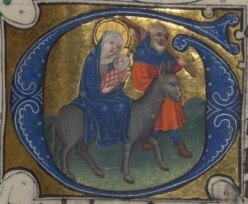
The Flight into Egypt, Walters Art Museum, MS W.188, f.112r
It’s been a while since I last posted, and for that I apologize. As some of you may know, along with my Boston manuscript colleagues I have been busy this fall with tours, public programming, and website development for the multi-venue exhibition, “Beyond Words: Illuminated Manuscripts in Boston Collections.” The show is starting to wind down, and two of the three venues have closed (the Isabella Stewart Gardner Museum venue will be open until mid-January). But even if you didn’t get a chance to see the show in person, you can still access the exhibition’s searchable online catalogue here. We will continue to update these records with images, codicological descriptions, and other material, and will soon be adding batch-download functionality.
But I digress…
In addition to my day job at the Medieval Academy of America and my work on the exhibition, I teach one course each year as an adjunct at the Simmons School of Library and Information Science. The class, “The Medieval Manuscript from Charlemagne to Gutenberg,” is an introduction to working with pre-1600 manuscripts. I give my students a crash course on paleography, codicology, and illumination, certainly, but because these are library students, the real focus of my curriculum is identification, cataloguing, and metadata. The care and feeding, if you will, of pre-1600 manuscripts. If this blog has taught me anything, it’s that special collections librarians working in North America are fairly likely to encounter this kind of material at some point in their careers. I want my students to know what to do when they open a desk drawer someday and find a file with some single leaves in it, or discover a previously-overlooked box in the stacks that is filled with binding fragments. This sort of things happens with some regularity in North American collections, and I want my students to be prepared.
What that means in practice is that I want them to know how to approximate a date/place of origin for a manuscript (is it French? English? Italian? Twelfth century or fifteenth?). I don’t expect them to become Bernhard Bischoff over the course of one semester, of course, but I do expect them to master the basics. Because the odds are pretty good that they’ll find themselves working with single leaves in particular (again, if this blog has taught me anything…), I also want them to know how to identify the text on a dismembered manuscript that, again more likely than not, is going to have come from a Book of Hours, a choirbook, or a Bible (to help with that process, I developed this digital “flowchart”). Most of all, I want my students to know how to craft clean, consistent, and appropriate metadata in an open-access platform that will make these objects discoverable, retrievable, and accessible to colleagues, students, and scholars worldwide.
For the most part, my library science students have a different background and different professional goals than students in a doctoral program, and they come to me with a different skillset that reflects their pasts and anticipates their futures. By the time they are advanced enough students to take an elective course like mine, they’ve already been introduced to various metadata models, cataloguing strategies, and modes of digital scholarship. I don’t have to teach them about the importance of consistent, clean data, because they already know. I don’t have to explain to them what TEI is, or Dublin Core, or LC authorities. I don’t have to convince them that MARC records are problematic for primary source material or explain the many uses of a well-crafted 500 field. When they show up for the first day of class, they already understand the importance and function of a well-structured metadata record.
This brings me to my main subject, digital reconstruction.
I have written several times about “digital fragmentology” and my project to digitally reconstruct the Beauvais Missal. I’ve found 103 leaves so far and will continue to update the website as more leaves are identified. I’ve learned much about the manuscript over the course of this project and will be publishing some preliminary findings in 2017. That project, a test-case for the Broken Books application, is up and running here. The Broken Books application, spearheaded by Debra Cashion at St. Louis University, uses a data model specifically designed for use with single leaves, serving them up using a IIIF-compliant model that retrieves digital images from holding collections and sequences them in a Mirador shared canvas.
But why do it? Why reconstruct broken books? What do we gain from the effort, other than perhaps a small moral victory over the biblioclasts? How many late fifteenth-century Books of Hours from Rouen does the world really need? We all know that many dismembered manuscripts weren’t necessarily high art or of great textual import. Many were already incomplete or damaged before they were broken up, a feature that biblioclasts often used to justify their actions. I would argue that recovering a lost text or major work of art in these books can’t be the only goal, as such discoveries are not guaranteed outcomes. I propose a different rationale. Instead of reconstructing these manuscripts solely for the sake of broader scholarship, we should look inward, embarking on these projects as pedagogical journeys for the sake of our students. A chance encounter with mold brought me to this conclusion.
In a typical year for my Simmons course, I spend half of the class sessions teaching from pre-1600 manuscripts in the Rare Book Room of the Boston Public Library, a collection I know well, having spent several years cataloguing it. I assign each student a detached leaf from the collection to catalogue and present to the class as their final project. Two weeks into the 2015 fall semester, however, “A significant mold outbreak … forced the Boston Public Library to close its Rare Books Department for five to 10 weeks after staff found fuzzy white spores on a medieval manuscript and other prized items in the renowned repository…” Boston Globe, 18 Sept. 2015).
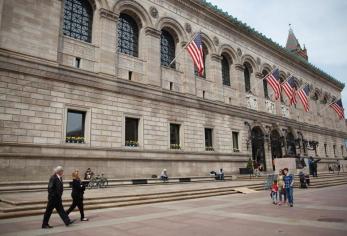
Boston Public Library, Copley Square
This was very bad news, of course, not just for the manuscripts, but for my class. Always one to take advantage of a teachable moment, I began class that day with a discussion about the long-term effects of humidity and temperature on parchment. But I was left with a serious problem. Learning that the Rare Book Room would be closed for months, I had to essentially throw out my syllabus midstream and rethink my entire plan for the semester. How could I achieve my desired learning outcomes if my students didn’t have unfettered access to a public collection of pre-1600 manuscript codices and leaves?
The show-and-tell piece was easy to resolve. My friend and colleague Ruth Rogers offered to let me bring my students twice to nearby Wellesley College to look at their very fine collection of medieval and Renaissance manuscripts. The final project was more challenging to re-imagine on the fly.
At that time, my Beauvais Missal project was well underway and beginning to bearing fruit, so I decided to try a similar digital reconstruction project with my Simmons students. First, I had to select a dismembered manuscript for my students to reconstruct. Here is where Otto Ege comes in.

Otto F. Ege (1888 – 1951)
If you are regular reader of this blog, it will be old news to you to read that in the 1930s and 1940s, Cleveland dealer/ teacher/ collector Otto F. Ege, among other biblioclastic deeds, used the leaves of several dozen manuscripts to create thematic “portfolios” for sale. In other words, he (and after his death, his widow Louise) would take one leaf of this manuscript, one leaf of that one, one leaf from a third, and so on, and pile them up into a deck of manuscript leaves, each of which was from a different codex. The leaves in these portfolios are always sequenced the same way. Number 5 in one portfolio comes from the same manuscript as Number 5 in every other portfolio of the same name. The most common of these portfolios are titled Fifty Original Leaves from Medieval Manuscripts; Original Leaves from Famous Bibles; and Original Leaves from Famous Books. Each leaf was annotated with its title and date and place of origin, adhered with acidic masking tape into a highly acidic matte, adorned with Ege’s letterpress label, and, the case of the Fifty Original Leaves set, stored with its 49 partners in a custom buckram box.
The leaves are presented in roughly chronological order (although Ege’s attributions are certainly debatable). In the Fifty Original Leaves set, these range from no. 1, a twelfth-century annotated lectern Bible, to no. 50, a late fifteenth-century bâtarde Book of Hours. These manuscripts were not chosen for their artistic excellence (although several of them are quite attractive); they were selected to illustrate a particular interest of Ege’s, the history of letterforms, with examples of romanesque script and various varieties of Gothic, as well as cursive, bâtarde, and humanistic hands. As an aside, it is worth noting that many of the manuscripts likely originally included miniatures, which Ege would have sold or given separately; the effort to reunite the excised miniatures with the Fifty Original Leaves manuscripts is just beginning, and until now has been mostly a matter of luck. Digital fragmentology projects will greatly enhance such efforts.
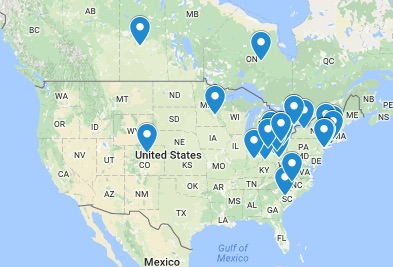
Known locations of Otto Ege’s Fifty Original Leaves of Medieval Manuscripts portfolios.
Ege’s wife Louise assembled forty of the Fifty Original Leaves portfolios shortly after Otto’s death in 1952, of which thirty intact portfolios have been identified (for more on the portfolios, see Scott Gwara’s book, Otto Ege’s Manuscripts). Think about that. That’s already thirty leaves of each of those fifty manuscripts, easily identifiable, easily digitized, wrapped up in a neat little buckram package. That’s a great place to start. Here’s a list of known Fifty Original Leaves numbered sets:
| Collection | Location | Set No. |
| Ohio State Univ. | Columbus, OH | 2 |
| Yale Univ. | New Haven, CT | 3 |
| Cleveland Institute of Art | Cleveland, OH | 4 |
| Ohio University | Athens, OH | 5 |
| Univ. of Massachusetts, Amherst | Amherst, MA | 6 |
| State Lib. Of NY | Albany, NY | 8 |
| Cincinnati Public Library | Cincinnati, OH | 9 |
| Wadsworth Athenaeum | Hartford, CT | 10 |
| Buffalo and Erie County Public Library | Buffalo, NY | 11 |
| Toledo Museum of Art | Toledo, OH | 12 |
| Univ. of Minnesota | Minneapolis, MN | 13 |
| Kent State | Kent, OH | 15 |
| Art Gallery of Ontario | Toronto, ON | 16 |
| Univ. of Toronto | Toronto, OH | 17 |
| SUNY Stony Brook | Stony Brook, NY | 19 |
| Cleveland Public Library | Cleveland, OH | 22 |
| Kenyon College | Kenyon, OH | 23 |
| Lilly Library, Indiana Univ. | Bloomington, IN | 24 |
| Univ. of Saskatchewan | Saskatchewan, SA | 25 |
| Univ. of South Carolina | Columbia, SC | 27 |
| Pierpont Morgan Library | New York, NY | 28 |
| Lima Public Library | Lima, OH | 29 |
| Denison Univ. | Granville, OH | 30 |
| Univ. of Colorado | Boulder, CO | 32 |
| Sold by Christie’s, 25 June, 1997, lot 16 | [unknown] | 33 |
| Newark Public Library | Newark, NJ | 34 |
| Rochester Institute of Technology | Rochester, NY | 35 |
| Ontario College of Art and Design | Toronto, ON | 36 |
| Case Western Reserve University | Cleveland, OH | 37 |
| Univ. of North Carolina-Greensboro | Greensboro | 38 |
| Sold by Christie’s, 30 January, 1980, lot 212. | [unknown] | 39 |
| Smith College | Northampton, MA | s.n. |
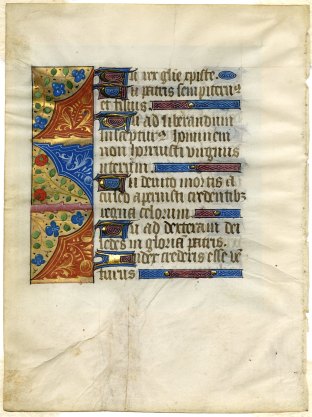
Fifty Original Leaves no. 47 (Smith College, MS 35.47v)
For my 2015 Simmons students, I selected Fifty Original Leaves, leaf no. 47. This is a fairly non-descript late fifteenth-century French Book of Hours, perfectly nice, but nothing unusually spectacular. I chose it in part because of its ease of legibility, but also because, unlike some of the other leaves, it has no foliation. For a classroom project such as that I had in mind, foliation would kind of defeat the purpose.
While working on my Beauvais Missal project, I’ve traveled around the country photographing Fifty Original Leaves sets, so it was easy, between the already-digitized sets and my own JPGs, to collect images of twenty-one leaves of the manuscript, one leaf for each student. I set up a shared Dropbox folder and uploaded the images; I labeled each with an abbreviated repository name, randomly naming the sides a and b (determining recto and verso was part of the assignment). The first step was for each student to catalogue their leaf, using such resources as Roger Wieck’s Time Sanctified, the Clemens/Graham textbook Introduction to Manuscript Studies, and the online Hypertext Book of Hours. Once they identified the text on their leaf, they catalogued it in Omeka and then placed it in the appropriate section of the exhibit space (Matins, Nones, the Office of the Dead, and so on). For this part of the exercise, they had to compare their leaf to others in the same section that had been catalogued by their classmates and determine the proper sequence of leaves. They identified several consecutive leaves during this part of the assignment.
Once that portion of the project was complete, the analysis of the reconstructed manuscript began. I divided the students into groups and assigned them different features of the manuscript to investigate further and present online: the manuscript’s origin and use; its history; and its illustration.
Once the students catalogued their individual leaves and started analyzing what they had done, they made amazing and important discoveries: using the Schoenberg Database, they discovered that, when whole, the manuscript had been owned by Estelle Getz, and that it was MS 7 in her collection in the de Ricci Census (I:12) as well as no. 70 in Ege’s (II:1948) (by the time de Ricci got around to cataloguing Ege’s collection Ohio, Mrs. Getz had dispersed her California-based collection, which is why the manuscript appears in the Census twice); from the 1936 Anderson sales catalogue of the Getz collection, a catalogue that can be found in the Internet Archive (lot 1059), they were able to determine the precise sequence of the sections of the manuscript, some of which are atypical, and recover a list of the miniatures that had originally been part of the codex; and – even though the usual signposts of Obsecro Te and the antiphons and chapter readings of Prime and Nones are not extant – one of the students, Katherine Philbin, determined that the manuscript was made for the use of a woman from Troyes, by researching an unusual Marian text preserved in the manuscript and by studying the recovered responsories for the Office of the Dead. This research was done almost entirely using online resources. The project was so successful that several of the students, including Katherine, have continued to work on the site even though the class technically ended in December 2015. Several more leaves have been added and additional discoveries explained. And so, thanks to an unfortunate mold outbreak at the Boston Public Library, my students had the opportunity to catalogue a set of related single leaves and curate an online fragmentology project. There are so many fragmented manuscripts out there that I could – and will – run this project in my class for years without circling back to the same manuscript.
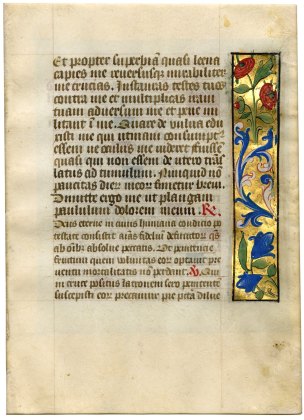
Fifty Original Leaves no. 48 (Smith College, MS 35.48r)
This year, I put my students to work on Fifty Original Leaves, leaf no. 48, and the results were just as enlightening. What was once just another “late fifteenth-century French or Flemish Book of Hours” can – thanks to their research – be re-catalogued as a late-fifteenth century Book of Hours from Northeast France, made for a woman and for the Use of Châlons-sur-Marne, preserving Wace’s French poem “La Vie de Sainte Marguerite,” with one identified miniature to boot.
The upshot is this: If your collection owns a Fifty Original Leaves portfolio, you may want to update your metadata with this new information for leaves 47 and 48. You’ll be able to add additional details to your records by searching for your leaf on each site, where you will find identifications of the particular text preserved on your leaf (this is also true for Beauvais Missal leaves, which are Fifty Original Leaves no. 15 but are also found independently of portfolios). As for next year, I’m already gathering images of Fifty Original Leaves leaf no. 30.
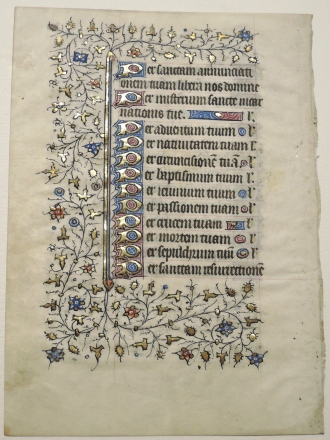
Fifty Original Leaves no. 30. What will we learn next year?
I’m far from the first person to suggest that the Ege leaves are perfect case studies in reconstructing broken books. Barbara Shailor was the first to see the potential applications of burgeoning digital technologies in her visionary article, “Otto Ege: His Manuscript Fragment Collection and the Opportunities Presented by Electronic Technology” published in the Journal of the Rutgers University Libraries in 2003, when digital technologies were in their infancy. In that article, she exhorts us to action, declaring that “the advent of electronic technology holds remarkable promise for re-assembling the fragments.” Her call was answered soon afterwards by Fred Porcheddu at Denison University, who developed an online collection of siloed images of several Ege portfolios, accessible by repository or by manuscript. That project was abandoned several years ago, however, and it has not been updated in some time. Other incipient projects have been designed as static siloes that don’t incorporate the interactivity and interoperability that are not only ideal but represent best practices in digital humanities. Users want and need to do more than just look at images, or even just download them. They want the images AND the underlying data, and they want to be able to take it, manipulate it, and use it. In the words of Will Noel at his 2016 Medieval Academy plenary, data should be promiscuous.
At long last, technology has caught up to our dreams and Shailor’s vision can now be fully realized. With well over 30,000 single leaves housed in more than 500 North American collections, there’s a lot to do. Some projects are already well underway, such as the work on Fifty Original Leaves no. 8 (a.k.a. the Wilton processional) being done by Alison Altstatt (Univ. of Northern Iowa). The Broken Books application is still in beta-testing, but I hope to be able to use it with my class in 2017. Using this platform in the classroom, IIIF-compliant images of a fragmented manuscript can be drawn into the shared canvas viewer to create a digital surrogate of the original codex; but the Broken Books platform allows students and scholars to do much more than that. With multiple annotation and viewing options, the reconstructed manuscript becomes more than the sum of its leaves. The cloud-based technology also widens the scope well beyond the classroom. Using the scattered Fifty Original Leaves portfolios, which themselves represent a well-defined corpus, students in any classroom worldwide will be able to collaborate on such projects. In the process, they will be initiated into the fragment-centric data model developed by the Broken Books team, a model they can use to dig deeper into the subject manuscript. Each leaf can be easily catalogued individually and also studied as part of the whole, leading to several important learning outcomes: a deeper understanding of the subject manuscript, its origins, function, contents, and history; and strengthened (and marketable) skills as digital humanists. In other words, students can work with fragmented medieval manuscripts in a context that values interoperability and clean, well-designed data, studying old books in a brand new way.

A question,really. You mention the use of a “flowchart” in your introduction to medieval mss summer course at Simmons. I can’t seem to access it…any ideas?
This website is AMAZING! I’m just a rank novice ( retired high school teacher ) in this area of study but I have taken several classes at the University of Virginia’s Rare Book School in the field of medieval manuscript studies. I am eager to go through this MRT blog., Thank you for the hard work you have invested.
Phil Garmey
Lynchburg,Virginia
pgarmey@ves.org
Thanks for your message! If you’ve been taking courses at RBS, then you are well on your way. The instructors there are amazing. As for the flowchart, try this link instead: https://1drv.ms/p/s!AqZZDAxh__i1vl4wDwlJ3Wi8SRur. Let me know if that works!
Pingback: An Ibadi Manuscript at Columbia University | مخطوط إباضي في جامعة كولومبيا |
Fascinating…
Relating to fragmentation of medieval manuscripts as an independent science is well overdue. In Hebrew manuscripts, we Fragmentologists have been functioning for almost a century. Most of us have been serving the research of the Cairo Genizah, where manuscripts have been scattered, often as no more than bifola, among over a hundred institutions, libraries and private collectors. So too in relation to the thousands of folia of Hebrew Manuscript, much of it confiscated by the Christian Church, found in reuse as binding material throughout Europe. Only 66 have turned up so far in American collections, but development in search methods should turn up much more.
Subsequently, much of the professional literature of Fragmentologists is in the same language as the Manuscripts- Hebrew. I’ll be glad to help those with specific questions to navigate this literature.
Ezra Chwat
Manuscript Bibliographer,
The National Library of Israel, Dept. of Manuscripts
ezra.chwat@nli.org.il
Pingback: Fragmentarium: a Model for Digital Fragmentology | Manuscript Road Trip